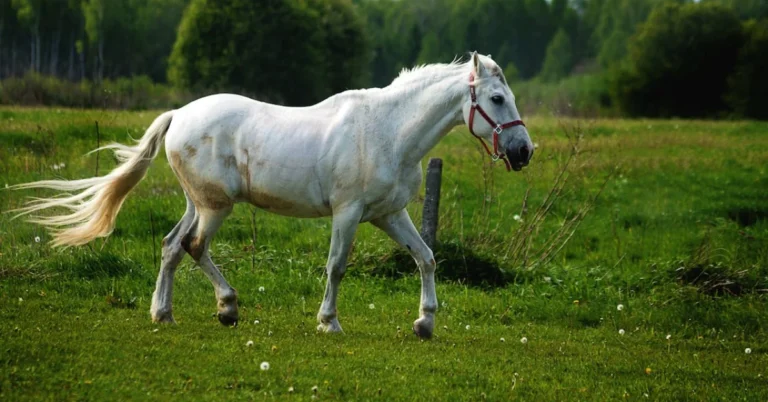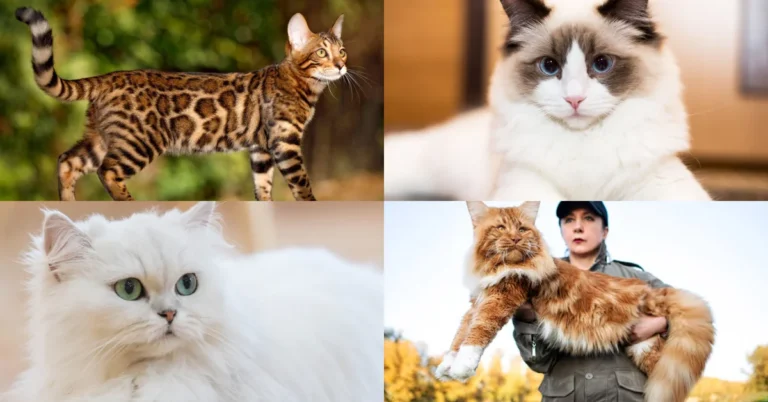For centuries, husky dog breeds have captured our imagination with their wolf-like appearance, piercing blue eyes, tireless work ethic, and larger-than-life personalities. The word “husky” conjures up vivid images of sled dogs racing across snowy landscapes, trusted companions keeping Arctic explorers company through endless nights, and goofy family members intent on stealing sofa space and snacks.
But did you know there are actually 20 major types of huskies breeds recognized worldwide? From the famous Siberian husky to more obscure Nordic descendants, the husky family encompasses a remarkably diverse range of canines, including calm dog breeds that may surprise you with their serene temperament.
While some types of huskies share key traits like thick furry coats, alert expressions, and indefatigable energy, each breed offers unique characteristics too. Some, like the imposing Alaskan Malamute excel at heavy lifting thanks to their burly frames, while others like the diminutive Alaskan Klee Kai suit city living better with their smaller stature.
No matter your lifestyle or experience level, at least one husky breed exists capable of fitting perfectly into your household. Read on to uncover 15 magnificent varieties and find your ideal matched!
1. The Siberian Husky
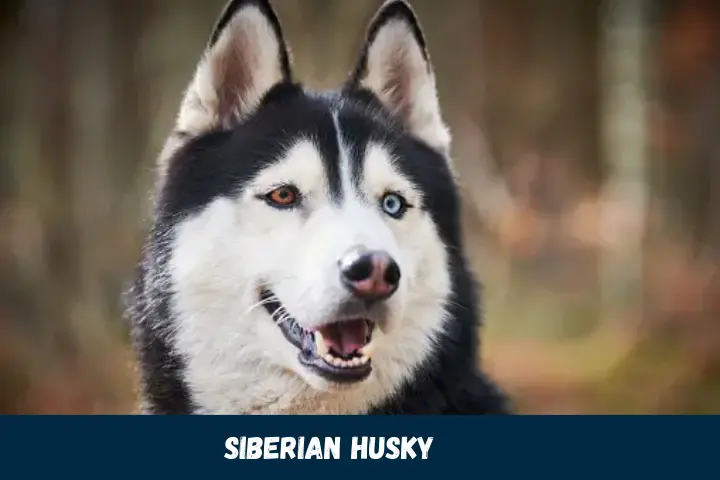
No list of husky breeds would be complete without top billing going to none other than the undisputed superstars of the mushing world – Siberian huskies. Weighing 35-60 pounds and reaching 21-24 inches tall, Siberian huskies, one of the most popular dog breeds, boast the archetypal husky look with their thick double coats, erect triangular ears, and sweetly shuffling gaits.
What truly sets Siberians apart lies beneath their striking facades though. These dogs overflow with seemingly endless supplies of energy, unmatched intelligence, and iron self-will. Siberians still retain the untamable spirits that allowed their ancestors to endure grueling months hauling heavy sleds across vast frozen landscapes.
Prospective owners beware – bored or under stimulated Siberians delight in turning destructive with home wrecking efficiency. However, for active owners able to provide vigorous daily exercise mixed with consistent training, you’ll find no more devoted or entertaining companion.
2. The Alaskan Malamute
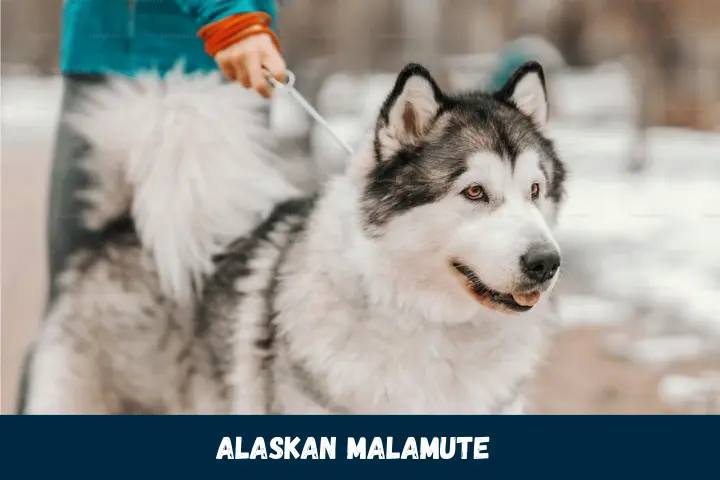
If the Siberian husky claims the prize for the classic husky look, the imposing Alaskan Malamute takes top honors for sheer size and muscle mass. Weighing up to 100 pounds and reaching 25 inches tall, malamutes resemble bears almost as much as dogs. Their broad heads, wide-set ears, and lumbering but powerful gaits exude raw strength.
But don’t let their intimidating bulk fool you. Alaskan malamutes boast amazingly sweet dispositions behind their brawn. They love children, graciously tolerate strangers, and can spend hours letting tiny humans clumsily “ride” them like ponies. At home, these gentle giants tend to follow their families from room to room, always hoping to assist with (or just snooze through) whatever activities might be going on.
Originally bred to haul heavy sleds for miles, modern malamutes still require vigorous exercise. These rugged dogs need conscientious owners willing to provide ample hard work or challenging backpacks to heft during long daily walks. Reward them well though, and malamutes pay back the effort with steadfast love and loyalty.
3. The Alaskan Klee Kai
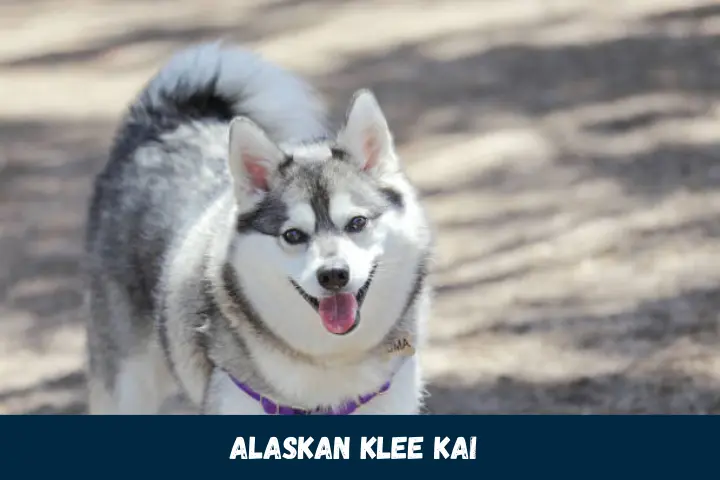
What happens when you shrink a Siberian husky down to a miniature size? You get an Alaskan Klee Kai! Ranging from 10-25 pounds and reaching 13-17 inches tall, Klee Kais always resemble tiny huskies in every way. The same thick fur coats, pricked ears, and ice-blue eyes exist wrapped in a conveniently compact body.
These adorable dogs showcase the best (and occasionally worst) traits of big huskies despite their petite bodies. Clever, energetic, and intensely devoted to their humans, Klee Kais want nothing more than to spend their days playing games, going on adventures outdoors, or snuggled inside receiving belly rubs.
Unfortunately, their small stature doesn’t diminish their husky vocal tendencies – be prepared for lots of talking and “awoo-ing!” Nor does it eliminate their destructive abilities when bored. Tiny tornadoes can whip through homes just as effectively as full-sized ones after all!
But for owners happy to provide sufficient physical and mental exercise, the rewards of sharing your days with an Alaskan Klee Kai prove immeasurable. Who can resist such a perfect pint-sized husky replica brimming with huge personality?
4. The Chinook
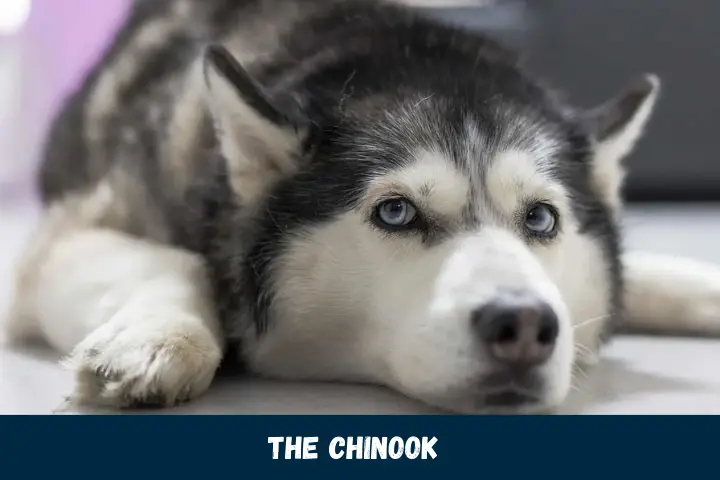
Back in 1917, Arthur Treadwell Walden set out to develop the ultimate sled dog by cross breeding huskies, mastiffs, German shepherds, and Greenland huskies. The resulting “Chinook” breed perfectly blended power, speed, gentleness, and athleticism in one trainable package. Handsome too with their tawny gold and white coats, these dogs exude personality as rich as their coloration.
Chinooks weigh 60-90 pounds, but they carry their heft gracefully and maintain pleasant, outgoing dispositions eager to please their owners. They love learning new things almost as much as they crave staying active outdoors. Smart and agile, Chinooks traditionally excelled at hauling heavy sleds and equipment through snow but also make enthusiastic hiking and jogging partners.
These energetic canines aren’t furballs however. Their short-haired coats shed moderately but require little specialized grooming. For active individuals or families capable of providing vigorous daily workouts, this rare husky/Labrador mix breed promises loyal, loving companionship for years to come.
5. The American Eskimo Dog
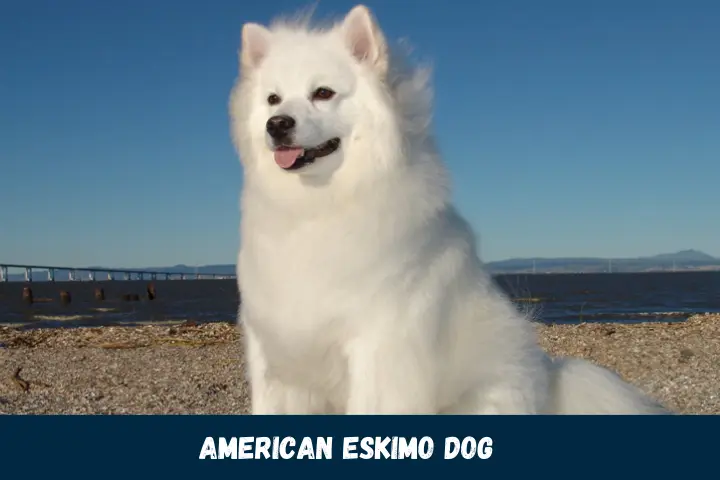
One glance at an American Eskimo dog and suddenly you’re transported back to an Arctic postcard scene complete with igloos, furs, and sleds. These striking pups boast the ultimate “husky” facade with their plush white double coats, sweet foxy faces, and constantly wagging furry tails.
Despite their name though, the American Eskimo breed actually began in Europe, not Alaska. First development started back in the early 1900s in Germany and Northern Europe. Only later did their popularity spread to the United States.
These perky pups come in three convenient sizes: miniature (under 12 pounds), standard (15-30 pounds), and giant (35-40 pounds). But regardless of height and weight, American Eskimos share identical sparkling personalities. Nothing delights them more than being part of family activities. They adore children, readily befriend strangers, and romp gleefully with other household pets too.
Just beware their protective instincts – American Eskimos tend to sound the alarm at the slightest odd noise. However, proper training and socialization from a young age helps temper their watchdog tendencies.
6. The Samoyed
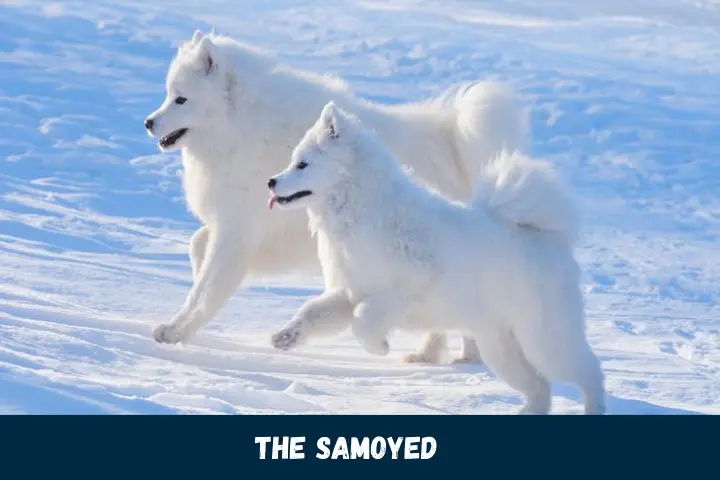
Blow the classic Siberian husky image up to a grand scale size complete with heavy white ruffs, huge furry paws perfect for snowshoeing across drifts, and that signature “Sammy smile” – and you’ve got the regal Samoyed breed.
Hailing from the Siberian Samoyede clan of the Nentsy people, Samoyed translates to “self-eating one,” a reference to these hardy dogs’ ability to hunt and survive independently in harsh conditions. Unsurprisingly then, behind their plush cream coats and gentle brown eyes lay tough endurance athletes, energetic herders, and bold guardians.
Yet for all their strength and power, Samoyeds thrive on being active beloved family members. They delight people of all ages with their playful antics and silly grinning expressions that earned them the nickname “Sammie smile.” At up to 65 pounds and 21-23.5 inches high, these amiable home guardians stay puppy-like and mischievous well into adulthood.
Prepare for wet kisses, games of chase, and deep snowy paw prints trailing these majestic marshals wherever they roam!
7. The Keeshond

What do you get when you cross a Chow Chow, Samoyed, Siberian Husky, and Pomeranian? You achieve the adorable spectacle wearing Keeshond! These foxy-faced charmers sport thick gray, black and cream coats delicately rimmed in black lines around their eyes and muzzles resembling old-fashioned glasses. Even their tipped ears and plumed tails carry delicate dark shadings.
Weighing 35-45 pounds at 17-18 inches tall, Keeshonds make their compact size work hard by radiating endless energy and optimism. Originally Keeshonds worked as watchdogs guarding barges and riverbocks in Holland. To this day, they maintain devoted protective attitudes when it comes to their families’ safety and happiness.
Despite their alert guarding instincts, Keeshonds love befriending strangers too. Their playful nature and eagerness to please endear them to everyone they meet. Train them well as ideal watchdogs who sound the alarm but welcome invited guests. Reward their efforts by providing regular tough chew toys, challenging treat puzzles, and always keeping another game ready to initiate. Clever Keeshonds crave regular mental stimulation and energetic playtimes within family circles. Establish yourself as their doting leader and receive unconditional love in return.
8. The Norwegian Elkhound
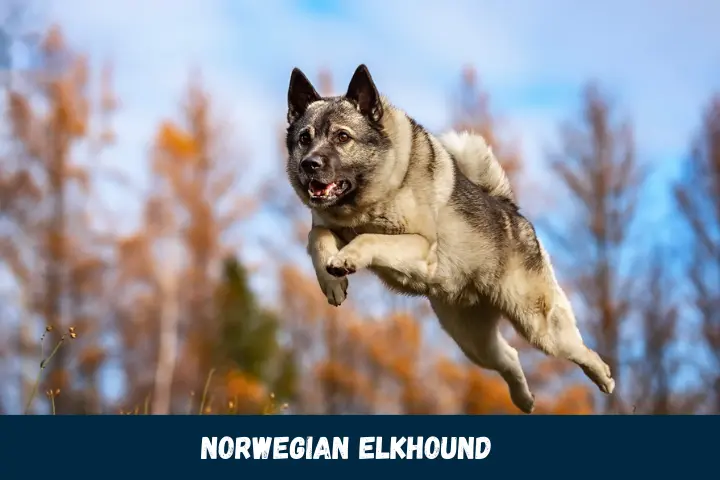
When Norwegian hunters needed powerful partners capable of facing down moose, bears, and even wolves at their sides, they developed the magnificent Norwegian Elkhound. Don’t let their gorgeous silver-gray coats and lively brown eyes fool you. These dogs rank among the most ancient of hunting breeds, forging a survival-based bond with humans spanning thousands of years.
Weighing 48-55 pounds at 19.5-20.5 inches tall, Norwegian elkhounds brim with self-assurance and pride at their heritage battling formidable prey while protecting their Viking families. Despite their courageous pasts though, Norwegian elkhounds eagerly apply their tireless energy and weather-resistant coats to all manner of modern activities.
They thrive when outdoors year-round, be it rain or snow, bitterly cold or sunny and warm. Vigorous hiking, jogging, or engaging in dog sports gives them satisfying jobs to succeed at today. Remember, this driven breed still needs strong leadership they can respect. Provide it positively, and they willingly follow you loyally anywhere.
9. The Shepsky
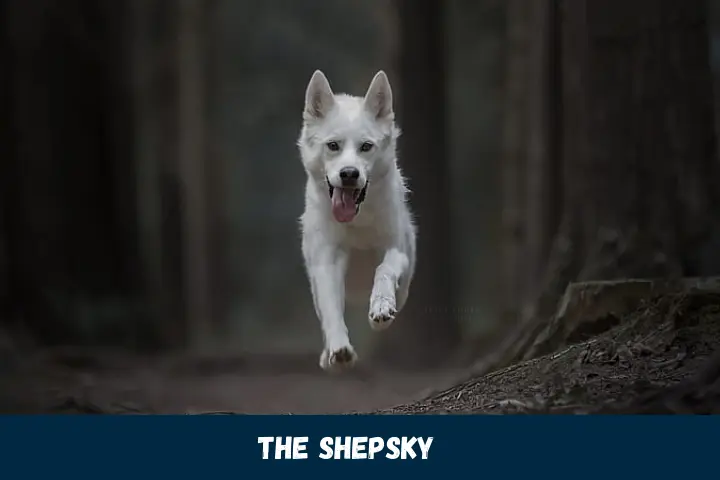
Combine the intelligence and trainability of a German shepherd with the independence and energy of a Siberian husky and you’ve bred the striking Shepsky hybrid. Fortunately, only the best personality traits of both parent breeds emerge in these active, amusing dogs.
Shepskies typically weigh 35-80 pounds depending on whether the husky or shepherd side runs stronger. Their thick coats also vary from black and cream to ginger red and white. But regardless of size and color, Shepskies overflow with lively confidence.
Naturally people-oriented, these energetic canines actively solicit attention and engagement. Expect to spend ample time enjoying vigorous exercise and lively training games that challenge their smarts. In return, Shepskies willingly accept jobs guarding homes or accompanying joggers and hikers. Their natural wariness towards strangers makes them excellent watchdogs if properly trained.
For owners seeking athletic partners full of personality and working drive, the striking Shepsky stands ready to please. Just ensure everyone in your household actively participates in meeting their enrichment needs, contributing to how to calm a dog down effectively.
10. The Mackenzie River Husky

Up in Canada’s remote Northwest Territories, the inhospitable climate and brutal traveling conditions demand exceptionally hardy dogs. Enter the Mackenzie River Husky. Weighing 55-80 pounds and standing 23-28 inches tall, these rugged ultra-athletes thrive on pulling heavy sleds at speed for miles on end.
Developed by the local Dene people, Mackenzie River Huskies proved vital for transporting vital supplies to tribes in perilously frigid and isolated areas of the territory. Their legendary toughness and endurance stem from crossing strains of Siberian huskies, Alaskan malamutes, border collies, German shorthaired pointers and more.
Unsurprisingly given their extreme mushing backgrounds, these dogs overflow with nearly inexhaustible energy. Additionally, their strong prey drives make coexisting peacefully with smaller pets difficult. For experienced owners living active outdoor lifestyles though, few companions can equal a loyal Mackenzie River husky.
11. The Canadian Eskimo Dog
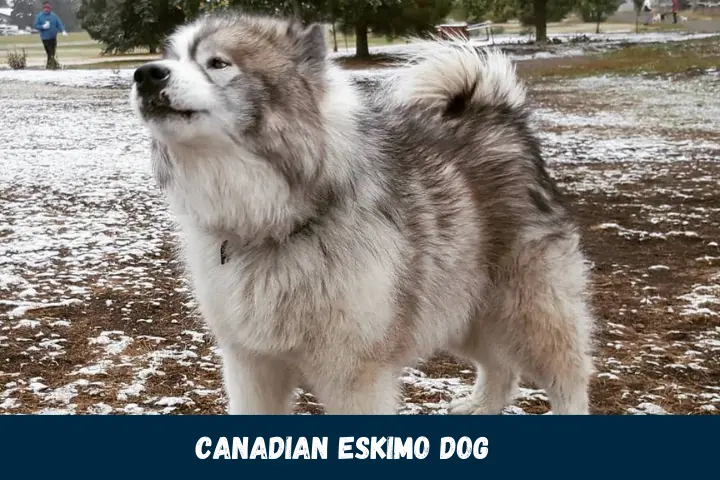
Majestic, powerful, yet also playful and intensely bonded with their human families – such stand as the greatest traits of the venerable Canadian Eskimo Dog. After thriving for centuries as vital Arctic survival partners, these sled pullers and polar bear scare-offs now rank critically endangered.
But thanks to focused preservation breeders, the supremely adaptable “Qimmiq” dogs of the Canadian Inuit continue hanging on. Standing 25-28 inches at the shoulder and weighing 55-80 pounds, these heavyset pups bear thewolf-life appearance and intimidating presence befitting their reputation battling fierce Arctic predators.
Yet behind their rugged exteriors lay gentle loyal spirits devoted to their owners. True to tradition, Canadian Eskimo Dogs remain energetic and tough enough to still perform sled pulling or weight carrying work duties today. Their home lives present them as chilled out compadres just as happy lounging with their families too. Provided potential owners live sufficiently active lifestyles in cold winter climates, these symbols of Canadian Aboriginal survival make rewarding companions.
12. The Utonagan
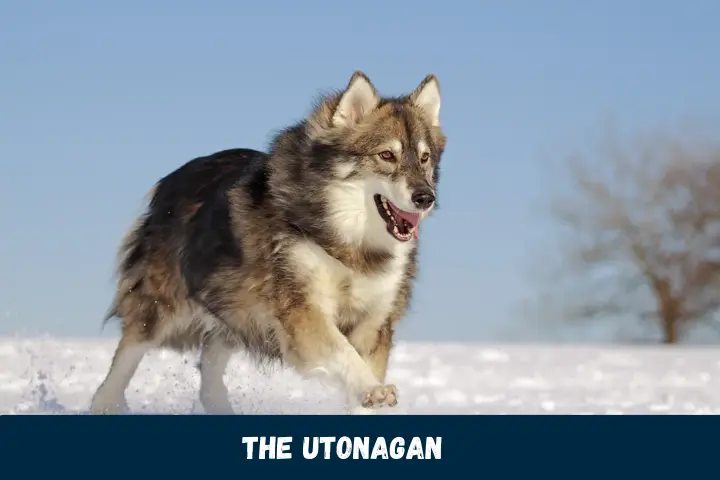
Canine breeders striving to recreate the aesthetics of wolves combined three dog breeds in Northern England during the 1980s – Siberian husky, German shepherd, and Alaskan malamute stock. Thus emerged the “Utonagan” breed, affectionately named after an Indian wolf deity, showcasing traits similar to a Border Collie Australian Shepherd mix.
These large imposing dogs reach heights of 24-30 inches and weights of 55-110 pounds when fully grown. Built for performance, Utonagans boast powerfully muscular frames covered in lush gray and white fur. Their wolf-like appearance even extends to long bushy tails, yellow stare-intense eyes, and haunting, melodious howls.
Thankfully though, the Utonagan temperament falls solidly on the gentle domestic dog side of the spectrum. They thrive when closely involved in family life as hiking partners, jogging companions, or snuggly sofa buddies. Utonagans only display aggressive or destructive behaviors if insufficiently exercised or mentally stimulated.
Provide ample outlets for their energy, regularly reinforce your strong leadership role, and these gentle wolf lookalikes become fabulous active housemates. Just be prepared for very vocal communicating and epic shedding courtesy of their Northern thick coats!
13. The Northern Inuit Dog
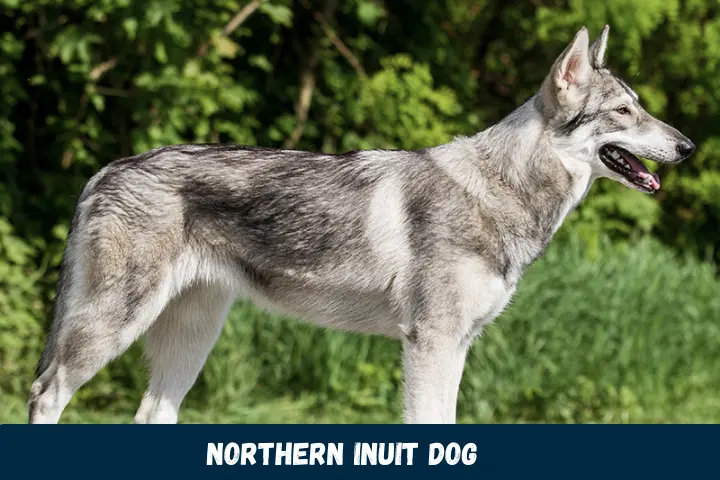
Canine breeds simply don’t come any closer in duplicating “Game of Thrones” direwolf aesthetics than Northern Inuit dogs. These burly British-bred pups stand rippling with muscles beneath their thick furry pelts that perfectly mimic gray direwolf coats. Fully mature, Northern Inuit males reach heights up to 32 inches tall and weigh 110-150 pounds.
Given the breed’s recent origins in the 1980s though, Northern Inuit dogs thankfully lack genuine wolf temperaments to match their intimidating facades. Instead, these gentle giants crave spending time with their beloved human families. A sure way to make them smile involves engaging in satisfying activities like obedience training, agility courses, sledding or weight pull contests.
That’s not to say Northern Inuit dogs will lounge around placidly as tame lapdogs. Expect high prey drives, a guarding nature towards strangers, and plenty of dramatic play bowing when they’re excited. Provided sufficient physical exercise and mental stimulation though, these striking wolfy-looking dogs enrich families with their amusing antics and steadfast devotion.
14. The Tamaskan
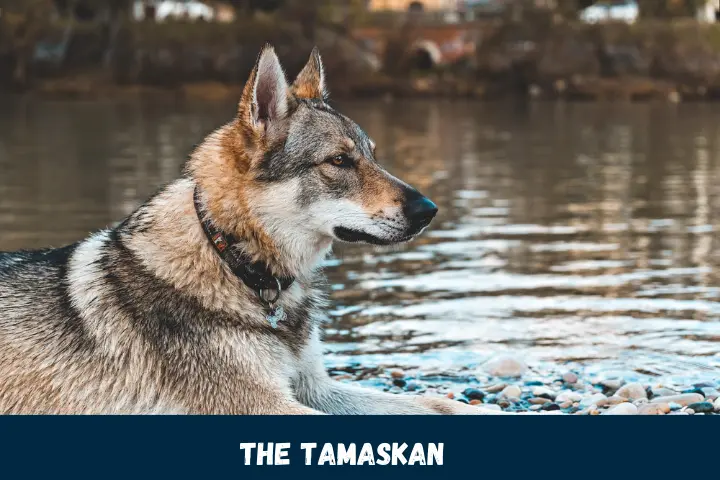
Seeking the alert poise and long-legged agility of a wolf dwelling in a domestic dog? Then check out the Tamaskan! First bred in Finland during the 1980s, careful outcrossing of Siberian huskies, Alaskan malamutes, and Czechoslovakian wolfdogs achieved gorgeous Tamaskan lines.
These athletic lupine lookalikes reach 24-28 inches tall and 37-84 pounds heavy depending on gender. Fluffy grey and white coats complete the icy wilds inhabitant facades. In motion, Tamaskans flow with willowy grace and speed belying their Northern thick fur.
Beneath those winter wolf coats though, passionate playful spirits are eager to bond with caring owners. Since human companionship ranks critical for Tamaskans, they don’t fare well isolated in backyard kennels. Allow them to share indoor family life instead.
In return, be prepared for devoted canine friendships as you hike, jog, skijor, bikejor, or road trip side by side. Tamaskans especially relish learning new dog sports or accompanying owners on outdoorsy adventures. Satisfy their needs for physical activity and close packed bonding, and they’ll happily follow you anywhere faithfully.
15. The Czechoslovakian Wolfdog
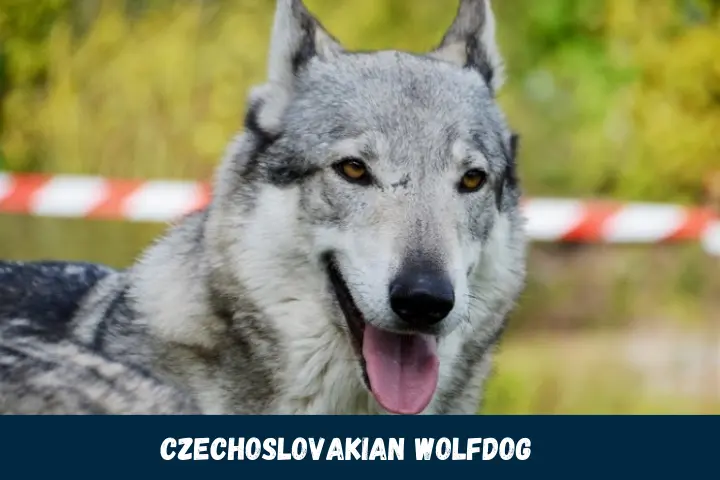
When a leading Czech breeder set out to create the ultimate forest ranger’s companion after WWII, he strategically blended Carpathian wolf bloodlines with German Shepherd dogs. Thus emerged the intimidating yet mesmerizing Czechoslovakian wolfdog breed.
Sporting wolf-like coloring, upright ears, and bushy tails, these working dogs reach 26 inches tall and weigh 55-88 pounds when fully mature. Don’t let their wild facades fool you however. Czechoslovakian wolfdogs thrive when treated as integral family members, not segregated backyard beasts.
That said, never forget their innate lupine instincts. These sensitive canines continue relying more on body language cues over verbal commands during training. Patience and bonding time are required when raising Czechoslovakian wolfdog puppies to earn their trust.
Provide proper socialization too so they can interpret normal human behaviors correctly while guarding homes. Reward their companionship with regular vigorous jogging, hiking, or competitive dog sports. Bored or lonely Czechoslovakian wolfdogs generally translate into massively destructive forces of nature though!
16. The Saarloos Wolfdog
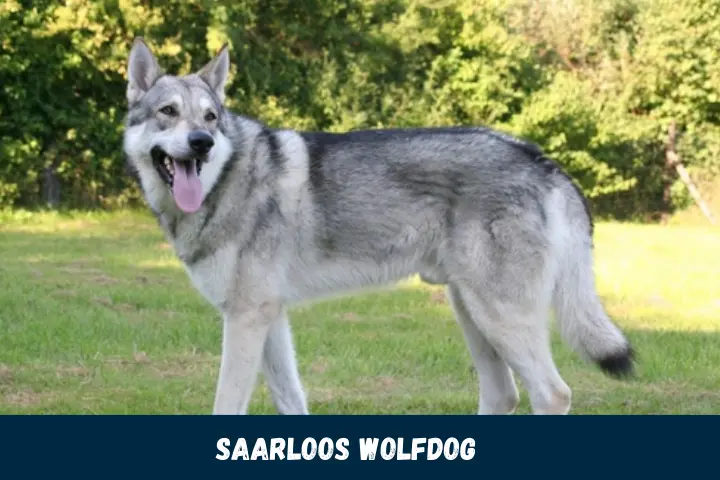
In the 1930s, a Dutch breeder named Leendert Saarloos sought to refine the German Shepherd’s natural wolf-like attributes by actually crossbreeding them with wolves. His pioneering vision yielded the magnificent Saarloos Wolfdog hybrid animals.
Saarloos wolfdogs showcase the rangy frames, domed foreheads, and charcoal patterned white/cream coats typifying wildlife prowling Europe’s forests. Attentively pricked ears and bushy downward tail carriage further enhance their noble wolf facades.
What sets Saarloos wolfdogs apart from wild wolves though lies in their innate patience and loyalty when raised properly alongside humans. Direct eye contact, physical handling, and vocal cues early on facilitate close communicative bonds with people.
Since wolfdog breeds can prove challenging for first-time owners, always research extensively beforehand. But if prepared to put in the effort, few companions prove more devotedly loving and entertaining than a well-socialized Saarloos wolfdog.
17. The Kunming Wolfdog
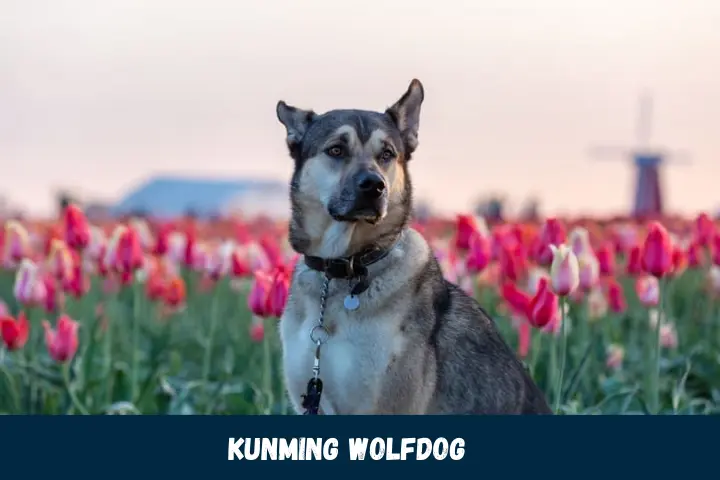
Seeking ultra-imposing personal protection canines dripping with ancient dynastic lore? Then investigate China’s controversial Kunming wolfdogs. Sometimes labeled Tibetan mastiffs, Chinese Emperor Wolfdogs, or simply Chinese guard dogs, these massive molosser canines trace Cold Mountain Kennel breeding origins near Kunming, China, during the 1980s.
Kunming wolfdogs typically possess masculine wolf-lion-maned ruffs framing intimidating scowling faces. Muscular dense frames covered in rich red, black, brown, or blonde fur complete the frightening guard dog facades. Most males stand 30 inches tall and weigh 120-200 pounds – females run somewhat smaller at 25 inches and 80 pounds.
Unsurprisingly given program roots training intimidating military and prison guard dogs, Kunming wolfdogs exhibit unwavering protective devotion towards their handlers and turf. Expect serious territorial behaviors towards strangers if not extensively trained and socialized early on though.
Additionally, scrupulously screen any breeders offering these controversial canines. Their rarity makes them costly status symbols vulnerable to unethical mass breeding conditions. But finding an ethical source yields unparalleled guardians.
18. The Alaskan Noble Companion Dog
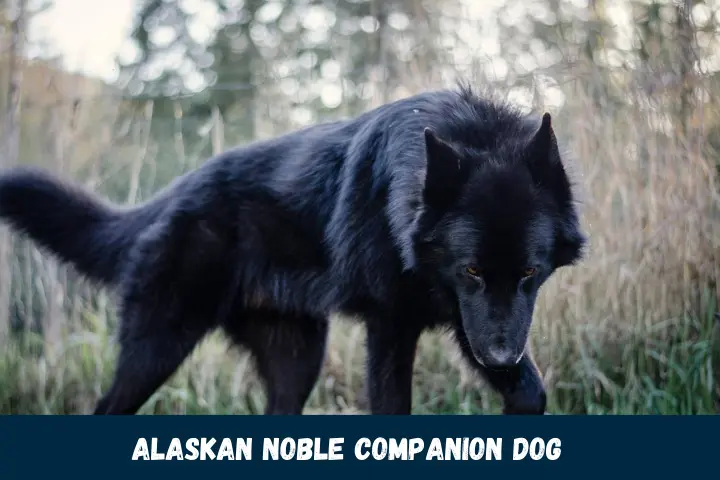
North America features wolfdog breeds too! Take the stunning Alaskan Noble Companion Dog or ANCD. These snowy-coated beauties entering the show ring sport expert blends of Northern sled dogs like Siberian huskies and malamutes infused with Mackenzie Valley wolf genetics introduced gradually over 35 years.
Alaskan Noble Companion Dogs reach 24-30 inches tall at the shoulder when adult once they finish growing at age four. Their substantial 80-120 pound frames carry powerful muscles sheathed in snowy white double coats. Black pigmented skin and amber eyes provide beautiful contrast highlighting their wolf-like crown hallmarks.
Breed founder Burr Traquair carefully selected friendly wolves and later generations for his breeding pool specifically seeking to avoid aggressive enhancement guarding behaviors. Instead, ANCD priorities focus on enhancing companion qualities: Intuitive support, relaxing therapist dispositions, eager obedience training responses, and wholehearted bonding loyalties.
19. The Pomsky
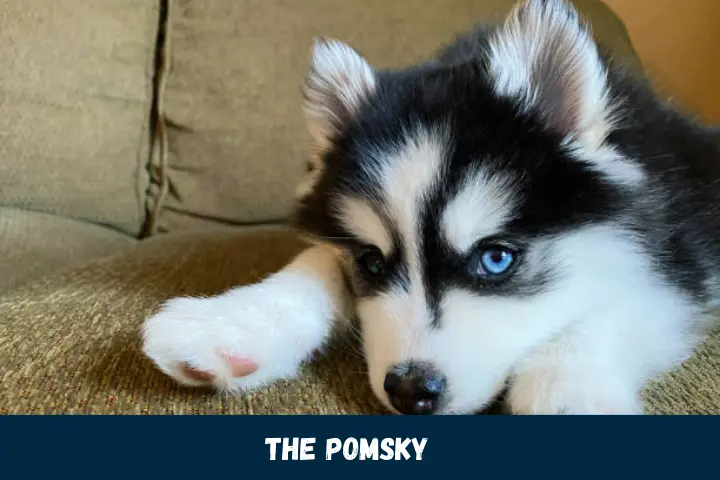
What could be cuter than miniaturizing a famously good-natured Siberian husky into a conveniently portable pint-sized pooch? Thus Pomsky breeders developed an adorable companion fusing Siberian husky and Pomeranian attributes through strategic crossbreeding.
Despite the cuddly implications their name suggests, Pomskies actually showcases a wide array of heights and weights depending on which parent they take after most. In general, Pomskies range from 15-30 pounds with smaller specimens leaning more Pomeranian and larger ones veering more husky-like.
Regardless of specific size though, Pomskies of all shapes share similar playful yet mischievous personalities. These active dogs demand plenty of toys for chewing, puzzles for mental stimulation, and consistent training to thrive as endearing family members.
Brimming with energy and too-clever wits, Pomskies definitely keep owners entertained daily. Just be sure everyone in the household actively participates in providing sufficient outlets avoiding boredom or destruction from manifesting! Properly cared for though, Pomskies promise faithful hilarious company guaranteed to make you smile.
Final Thoughts
Whether drawn to the reputable reliability of a Siberian legend or the allure of a rare Tamaskan lupine recreation, plenty of marvelous husky breed options exist spanning sizes, shapes, personalities, and colors to match ideal owners. Do your homework researching the requirements different types of huskies need for exercise, grooming, training, and loving leadership.
Be honest with yourself assessing if your family’s lifestyle can provide everything a particular husky breed needs to thrive both physically and mentally longterm. Actively including any northern dog in all facets of household life fosters deeper human bonding too – isolation outside bears devastating consequences personality-wise.
But commit fully prepared to rise sufficiently meeting the breed’s unique needs, and a devoted respectful canine soulmate able to enrich every adventure lies ready to leap exuberantly into your life unconditionally. Let the journey with your new husky friend begin!


